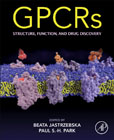
GPCRS: Structure, Function, and Drug Discovery provides a comprehensive overview of recent discoveries and our current understanding of GPCR structure, signaling, physiology, pharmacology and methods of study. In addition to the fundamental aspects of GPCR function and dynamics, international experts discuss crystal structures, GPCR complexes with partner proteins, GPCR allosteric modulation, biased signaling through protein partners, deorphanization of GPCRs, and novel GPCR-targeting ligands that could lead to the development of new therapeutics against human diseases. GPCR association with, and possible therapeutic pathways for, retinal degenerative diseases, Alzheimer's disease, Parkinson's disease, cancer and diabetic nephropathy, among other illnesses, are examined in-depth. Addresses our current understanding and novel advances in the GPCR field, directing readers towards recent finding of key significance for translational medicineCombines a thorough discussion of structure and function of GPCRs with disease association and drug discoveryFeatures chapter contributions from international experts in GPCR structure, signaling, physiology and pharmacology INDICE: GPCRs Structure and Activation 1. GPCRs: Seven transmembrane helical receptors 2. Advances in methodological strategies to study GPCR structure 3. Single domain antibodies targeting GPCRs for structural studies 4. GPCRs: Structural diversity in ligand recognition 5. Dynamic range GPCR activation 6. Structural water network essential for GPCR activation GPCRs Signaling - Structural determinants of GPCR - partner protein complexes 7. Origin of specificity in GPCR-G protein recognition 8. GPCR-G protein complex - a lesson from CryoEM 9. Structural determinants of GPCR-arrestin complex 10. Molecular assembly of GPCR-GRK complex Multimeric organization of GPCRs in biological membranes 11. Class A - Visual receptors 12. Class A - Dopamine receptor 13. Class A - Muscarinic receptor 14. Class B - Serotonin receptor 15. Class C - GPCR heterodimers 16. Spatial inhomogeneity of GPCR dimers GPCRs Allosteric Modulation and biased Agonism 17. Protease-activated receptors (PAR) 18. P2Y1 receptor 19. Adenosine A3 receptor 20. Free fatty acid receptors 21. Positive allosteric modulation of opioid receptors 22. Light activated positive allosteric modulators of GLP-1 receptor 23. Non-canonical signaling via GPCR-arrestin recruitment 24. GPCR-arrestin mediated signaling 25. GPCR-arrestin biased signaling activated by pepducins GPCR targeted drug discovery and disease treatment 26. GPCR targeted treatment of retinal degenerative diseases 27. Regulation of CB1 and CB2 - relevance for Alzheimer disease 28. Purinergic receptors - potential target for treatment Parkinson's disease 29. PAR1 modulators that suppress tumor progression 30. PAR2 promising target for breast cancer therapy 31. Divers activation of GPCRs - contribution to cancer 32. GPCRs - novel targets for type 2 diabetes 33. GPCRs - novel targets for diabetic nephropathy 34. Proteomic-based targeting new GPCRs ligands Progress in GPCRs de-orphanization 35. Strategies to discover ligands targeting orphan GPCRs 36. GPCR-CoINPocket, a novel strategy for de-orphanization of GPCRs 37. Strategies targeting neuronal orphan GPCRs 38. Role of GPR158/179 in regulation of G protein signaling 39. Novel ligands for GRP171 - potential therapeutics for food-related disorders (Gomez I, Devi LA, Icahn School of Medicine at Mount Sinai)
- ISBN: 978-0-12-816228-6
- Editorial: Academic Press
- Encuadernacion: Rústica
- Páginas: 552
- Fecha Publicación: 01/10/2019
- Nº Volúmenes: 1
- Idioma: Inglés
